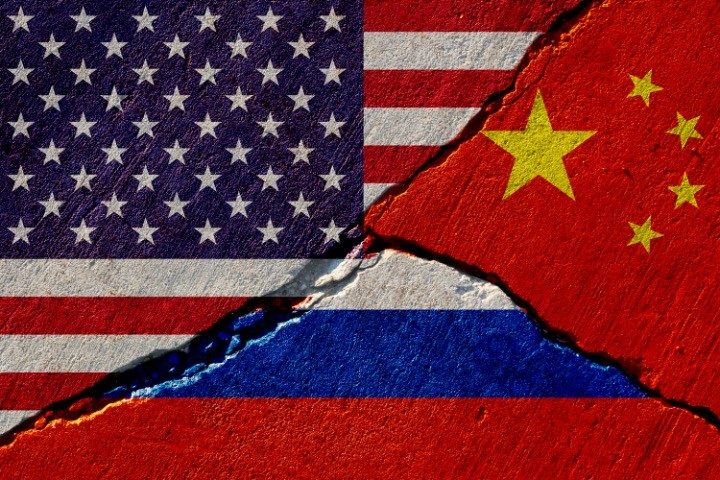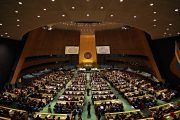
Tensions are escalating between Moscow and Washington as the latter attempts to use economic leverage to bring Russia to heel.
The American government this week slapped 20 Russian nationals and over 100 Russian companies onto its blacklist as a punitive measure for Russia’s military invasion of Ukraine, the outlet Russia Today reported.
The sanctions were made known via an updated blacklist released by the Office of Foreign Assets Control (OFAC) of the United States Treasury. Included in the sanctions were prominent Russian car manufacturers AvtoVAZ, Moskvich, GAZ Group, and Sollers. Also on the list was Avtodor, a state-owned firm, as well as Transmashholding — Russia’s biggest manufacturer of rail and locomotive equipment — and Ak Bars Bank, a top Russian universal lender.
Among the individuals targeted by the sanctions were Andrey Bokarev, former president of Transmashholding, and Iskander Makhmudov, who leads Ural Mining and Metallurgical Company. Another sanctioned individual was Igor Altushkin, who founded and remains the number-one shareholder of Russian Copper Company (RMK), the country’s third-leading producer of copper.
In addition to the Russian sanctions, the U.S. government also sanctioned 150 foreign companies and individuals from Georgia, Turkey, and the United Arab Emirates in order to enforce previous penalties on Russia.
The State Department accuses these sanctioned non-Russian entities of participating in the transfer of “dual-use goods,” such as optical filters, lithium batteries, high-performance filters, and drone cameras.
But as Reuters reported in July, the Russian auto industry is taking sanctions in stride. Its relationship with America strained due to the war in Ukraine, Moscow is getting even closer to China to keep its auto industry alive. For example, the Moskvich, a Soviet-era automobile, was brought back by the state-owned manufacturer AZLK by building the cars in Moscow using kits purchased from a Chinese partner.
Reuters noted the way in which Chinese auto industry players have quickly moved to get a strong foothold in Russia now that the West is cutting off Moscow:
Chinese carmakers are seizing market share in Russia, capitalising on the departure of Western players that used to dominate the market before the invasion of Ukraine, auto industry data shows.
Imported Chinese cars now account for 49% of Russia’s market, reaching 40,000 units in June, compared with a pre-war share of just 7% in June 2021, according to data from analytics firm Autostat.
It is a lucrative business. Chinese carmakers’ exports of passenger cars to Russia in January-June 2023 increased 6.4 times year-on-year to almost $4.6 billion, according to Chinese customs statistics published on Thursday, including exports worth more than $1 billion in June alone.
Beyond these figures, Chinese firms are also increasing their sales in Russia with vehicle assembly at factories vacated by the likes of Renault and Nissan (7201.T), Reuters found.
The outlet further reported that six car factories in Russia that used to be owned by American, Japanese, and European firms are now being used — or have plans to soon be used — for the production of Chinese models.
In February, amid the announcement of sanctions on 200 Russian individuals and entities, the White House stated: “These sanctions, export controls, and tariffs are part of our ongoing efforts to impose strong additional economic costs on Russia. We will continue to work with our allies and partners to use all economic tools available to us to disrupt Russia’s ability to wage its war and degrade its economy over time.”
Together, Russia and China have led the creation of a parallel global order that challenges U.S. hegemony and insulates those nations aligned with them from the economic intimidation America has traditionally wielded by its use of sanctions.
One notable example is Afghanistan. A pariah in the international community since the Taliban ousted the U.S.-backed government in August 2021, Kabul would seemingly be in danger of having its economy crippled by isolation.
Instead, the regime is flourishing thanks to commerce with foreign partners — notably China — who don’t care about the Taliban’s human rights record as the U.S. does. In fact, as The New American recently reported, China on Wednesday became the first nation to officially appoint a new ambassador to Afghanistan since the Taliban took power there.
Meanwhile, North Korean dictator Kim Jong Un’s recent meeting with Russian President Vladimir Putin demonstrates the inroads Putin is making with other rogue states as he continues to run his expensive war machine in Ukraine amid the West’s financial support of Kiev.
In a parallel of that meeting, Ukrainian President Volodymyr Zelensky is set to meet with Joe Biden in Washington next week and is asking America for additional funding to keep up the fight against Russia.
Is Washington’s strategy of crippling Russia by means of sanctions working? Or is it having the unintended consequence of making America’s rivals stronger by forcing them to come together in the development of their alternative world order?
In the diplomatic race, it appears Washington’s finest are being outrun by Moscow and Beijing.




